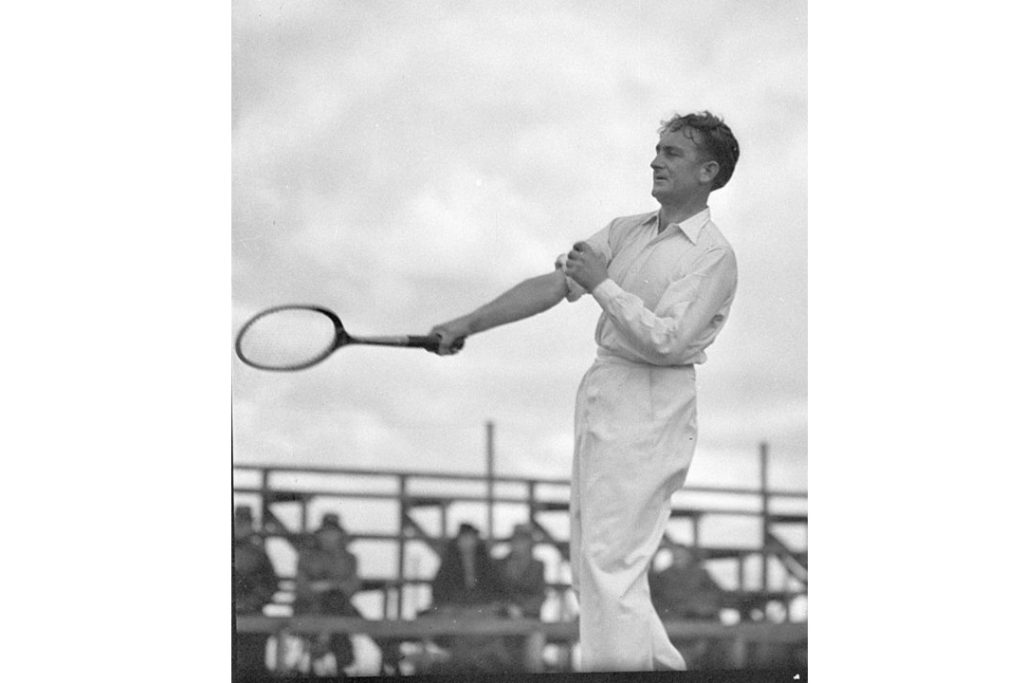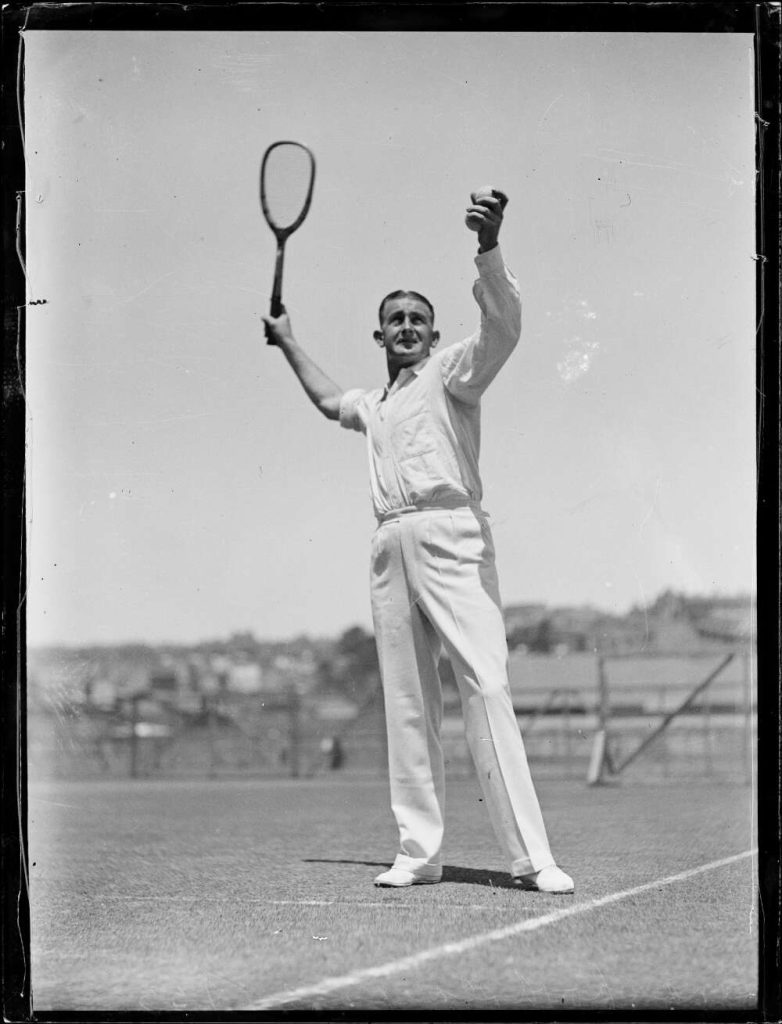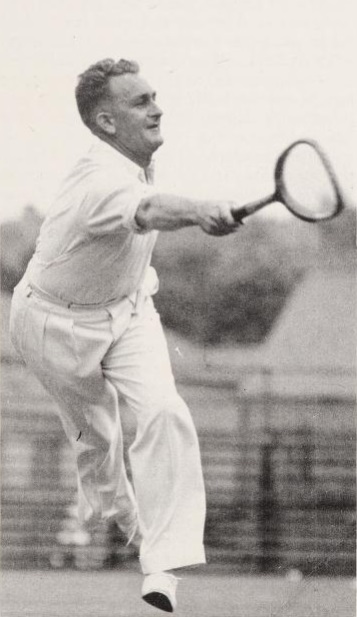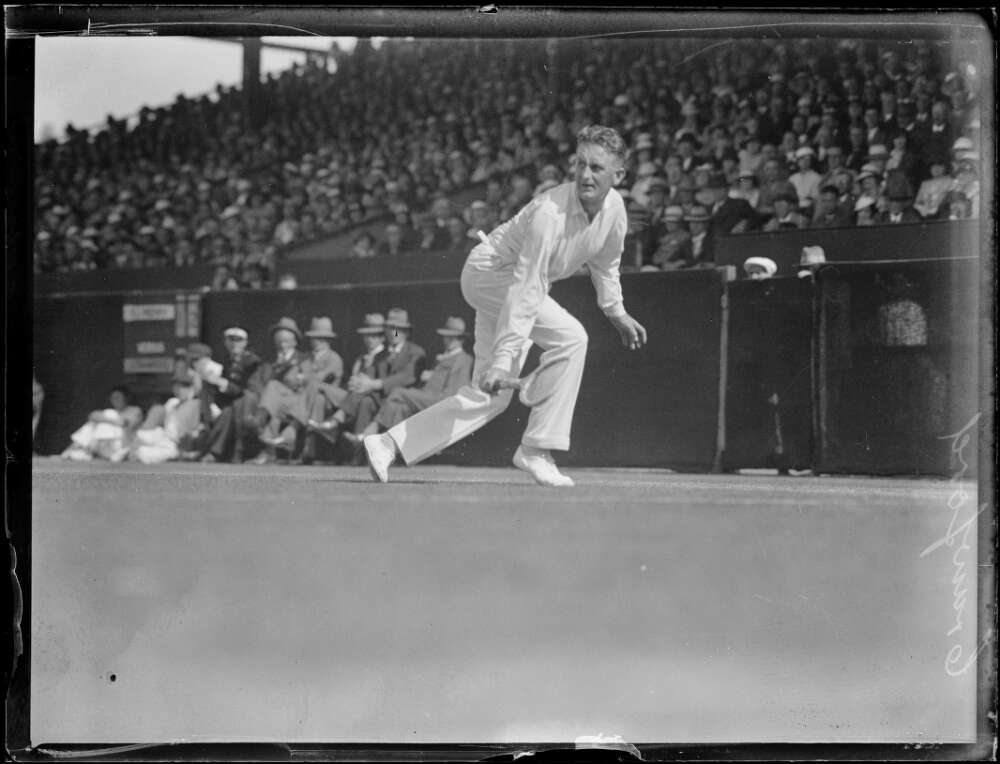In 2022, I’m counting down the 128 best players of the last century. With luck, we’ll get to #1 in December. Enjoy!
* * *
Jack Crawford [AUS]Born: 22 March 1908
Died: 10 September 1991
Career: 1926-51
Played: Right-handed (one-handed backhand)
Peak rank: 1 (1933)
Major singles titles: 6
Total singles titles: 66
* * *
Winning the Grand Slam has never been easy. If the variety of surfaces and conditions don’t get to you, the pressure will, as the target on your back keeps getting bigger and bigger.
Before the advent of commercial air travel, the logistical challenge was almost as significant. The first big tournament of the year was played in Australia, and that meant multiple weeks of traveling in each direction for anyone not lucky enough to reside Down Under. Even when Australians headed to Europe for Wimbledon and the Davis Cup, they didn’t always continue across the Atlantic to the fourth major of the year.
The modern tennis calendar took shape after World War I, and the majors took their present form when the French Championships opened up to foreigners in 1925. By the end of the 1920s, players were already talking about winning the four major titles. No one played all four until 1928, when Jean Borotra paired a round-the-world tennis tour with business travel in 1928. He won the Australian Championships, but he wasn’t quite good enough for a serious Grand Slam attempt. He didn’t win another major that season. The next year, Brits Bunny Austin and Colin Gregory made the trip. Gregory won the Australian title, but he didn’t bother to complete the quartet, skipping Forest Hills.
In 1933, a group of Americans made their own tour. The tall, slender Ellsworth Vines had ridden his unreturnable serve to titles at Wimbledon and Forest Hills the previous year, and he was seeded first in Melbourne. His Slam quest ended before it began, at the hands of 16-year-old Australian Vivian McGrath and his unorthodox two-handed backhand.
Fred Perry would complete the career slam by 1935, though an early exit at the French that year would stop him from winning all four titles in the same calendar year. The feat itself would need to wait only until 1938, when Perry had turned pro and Don Budge carefully executed his attack on the most hallowed courts of the tennis world.
But back in 1933, when Vines was supposed to pick up an easy win Down Under, the man who won the Australian title nearly pulled off the Grand Slam himself.
Jack Crawford, a 24-year-old farmer’s son from New South Wales, beat two of Vines’s traveling companions to win his own national title for the third consecutive year. After becoming the first foreigner to win the French title, he outlasted Vines in a Wimbledon final for the ages. He was within a set of the Grand Slam when, at Forest Hills, he finally ran out of gas and watched as Perry ran away with the trophy.
* * *
As the first man to win three majors in a single season, Crawford could tell you that winning four was an entirely different type of challenge. The accomplishment didn’t have the same cachet it does now, but fans were certainly watching. It was in Crawford’s great season of 1933 that sportswriter John Kieran borrowed a term from bridge and gave the four-major target its moniker: the Grand Slam.
Crawford could tell you how difficult it was, but he wouldn’t. Dubbed “Gentleman Jack” by his admirers worldwide, he was a throwback in almost every way. When he won, he said it was luck. When he lost, all credit to his opponent’s skill. At the same time that Bunny Austin began to popularize shorts on the tennis court, Crawford not only stuck with trousers, he wore long sleeves as well.
Crawford even preferred vintage equipment. After a friendly game with Norman Brookes, the 1907 and 1914 Wimbledon champion from Australia, Brookes offered him one of his old rackets, a model with a flat-topped head. It was old-fashioned even in Norman’s heyday, but Crawford adopted it when he realized it gave him a bit of extra power when he had to reach for his shots. He ultimately endorsed the racket and caused a belated fad in flat-tops in the 1930s.
What made the “Gentleman Jack” label so apt was that Crawford was absurdly economical of motion. He made tennis look easy because, most of the time, he didn’t bother to try very hard. Paul Metzler, who devoted a chapter to Crawford in his 1969 book, Tennis Styles and Stylists, wrote, “Never has there been a champion so indolently content to reach for wide shots or high lobs, or one so loath to run or leap for them.”
Jack played almost exclusively from the baseline. It took an awful lot of effort, after all, to make a dash up to the net.
Beneath the laid-back façade, however, was probably the most aggressive baseline player of his era. He rarely took more than a step behind the line, and he used the whole of his opponent’s court like no one else. He handled the fearsome Vines serve by stepping in to take it on the rise, and in rallies, he would concede so little territory that, in Metzler’s words, he “[gave] the impression of commanding the net, almost in the manner of a volleyer.”
* * *
Still, appearances were not entirely deceiving. Gentleman Jack sometimes needed to be encouraged to make an effort. He won his first major mixed doubles championship at Wimbledon in 1930, paired with the 38-year-old Elizabeth Ryan. Ryan had been winning Wimbledon titles since 1914, and she wasn’t about to miss another chance because of a lazy partner.
Harry Hopman–who also won doubles majors with Crawford–tells the story in his book, Aces and Places:
The hustling Miss Ryan found Jack’s lethargic mixed doubles game more than her patience could stand. She could see nothing funny in the half-joking references of their mixed play as “Ryan and Miss Crawford” because she was playing the net game more than her partner; she wanted to win the event and make it her sixth Wimbledon mixed doubles. So she kept niggling at Jack to make him intercept more and to move in to the net quicker–and she got results.
Crawford’s next three mixed doubles majors came alongside his wife, the former Marjorie Cox. Hopman credits Marjorie for a good portion of the competitive spirit Jack would develop:
Marjorie’s greatest success was in the power of her influence on Jack’s determination and will-to-win and in the intensification of his dislike of defeat which her support and encouragement so strongly increased. She was both a restraining influence and, at times, an acceptable excuse for the refusal of friendly but wearying offers of hospitality which provide so much fun, but do so little to raise an international sportsman’s competitive calibre.
Hopman would go on to train generations of Australian stars, instilling unshakeable work ethics in the best of them. Crawford clearly didn’t measure up to that standard. Writing of Jack just five years after his marriage, Hopman added, “He was beginning to take things a little more easily … [H]e did not practise so hard as before, nor as strenuously as some of the younger and ‘hungrier’ players.”
Hopman must have wondered what his friend could’ve accomplished had he possessed the work ethic of a Ken Rosewall or Ashley Cooper. Strong an opponent as Fred Perry was, a worn-out Crawford missed his Grand Slam by just one measly set.
* * *
Or, maybe Jack knew what he was doing.
Before his almost-magical season of 1933, the six-foot Crawford had gained 15 pounds, settling in at a distinctly un-tennis-like 185 pounds. John Tunis, writing for the New Yorker ahead of the US National Championships, called Jack “tremendously fast for a big man” and opined that his size worked in his favor:
[The additional weight] not only enables him to burn over a service ace now and then, and to put additional speed when necessary into his drives, but has also given him the stamina and resources to help him go through a twelve-month campaign which has almost ruined the game of a slender, nervous boy like Vines.
Journalists were unanimous that he was a joy to watch. Al Laney wrote, “I do not think any tennis player has given me more genuine pleasure than Jack Crawford.” Yet it was difficult to pin down exactly what made him so great.
He didn’t have an obviously powerful serve, especially when compared to someone like Vines. But Laney called him “one of the finest of servers,” and he used his flat delivery to open up the court. He was acclaimed for his low volleys–the flat-topped racket helped here–but he rarely came to net.
The most puzzling paradox is that observers couldn’t even agree which wing was Crawford’s strongest. Mercer Beasley, coach of Vines (and later Frank Parker), wrote, “We wouldn’t play a ball to Crawford’s forehand around the service line on a bet.” Vines agreed that Jack’s backhand was more fragile, and their Wimbledon final included long stretches where the two players simply tested each others’ weak points with backhand after backhand.
Yet less than two months after Crawford won his third major of the year, Alison Danzig of the New York Times wrote that his backhand “was thought to have no equal in its steadfastness.” Perry attacked Jack’s backhand at Forest Hills, and in Danzig’s interpretation, the strategy was meant to break down the Australian’s best shot, not his worst.
Hopman gives us a way out of the riddle. Writing in 1957, he ranked Crawford’s forehand higher than that of any Australian since. In his telling, the quality of the forehand, combined with Jack’s otherworldly anticipation, made the backhand look better than it was.
Whichever side was stronger, opponents barely had time to react, and they rarely knew what was coming. Crawford lost the 1934 French final in a five-setter to Gottfried von Cramm. He still made quite the impression on the German, who said, “I had never seen a man make such perfect lobs.”
* * *
Thanks to the reticence of Gentleman Jack, we don’t know exactly what happened between the third and fourth sets of the 1933 Forest Hills final. With the Grand Slam on the line, he dropped the first set to Perry, 6-3, came back to win a marathon second frame, 13-11, and took the lead in the third, 6-4. By convention, players took a ten-minute intermission between the third and fourth sets.
Crawford had asthma, and it had occasionally sidelined him earlier in his career. He learned to drink a little brandy during matches to manage the ailment, and he did so on this day. He seemed to struggle in the warm, muggy conditions, and he had appeared to be in physical distress during his semi-final victory over Frank Shields, as well.
It’s possible that the asthma was too much to overcome. Another theory is that he overdid it with the brandy. The cumulative fatigue of the long season might have gotten to him–he admitted that “he felt himself in a daze” even before the intermission.
A further possibility is that he was a bit too, well, gentlemanly during the intermission. Perry changed his clothes and got himself a massage. Jack, however, chatted with his wife while relaxing with a cigarette.
Perry’s account of the fourth and fifth sets? He “went mad.” The rest of the match barely took as long as the interval. Perry stormed back to win, 6-0, 6-1, taking 13 minutes for the fourth set and 15 minutes for the fifth. Was it the asthma, the brandy, the conditions, or the characteristic indolence? Or was Perry just that good? Crawford wouldn’t say. All that was certain was that, for at least one more year, grand slams would be limited to baseball and bridge.
* * *
Perry’s prowess doesn’t fully explain the result, or else Jack wouldn’t have built up a two-sets-to-one lead. But after that fateful intermission, the Brit had the better of the rivalry, and it wasn’t even close.
The two men faced off nine more times, and Perry won seven. In 1934, he straight-setted Gentleman Jack in the Australian final, and he won 12 games in a row to take that year’s Wimbledon in a rout. It was an awkward scene that Perry wouldn’t soon forget: Plenty of the home fans clearly sided with the Australian, and a Wimbledon club official told Crawford that the better man lost–in Perry’s hearing.
The casual classism further fueled Perry’s competitive fire. Crawford got the better of him in the 1935 Australian final, but when they met at Wimbledon that year, Perry once again put him away comfortably.
By then, Jack was earning a comfortable living endorsing his unusual rackets, and he was content to let Perry have the limelight. He remained competitive on the doubles court, winning the 1935 Wimbledon title with Adrian Quist and reaching the men’s doubles final in Australia as late as 1940. His casual on-court demeanor disguised an abiding love for the game: He entered the Australian Championships every year until 1951, and he played seniors tennis after that.
It was common practice for decades that, when a match concluded, one player would jump the net on the way to shaking his opponent’s hand. When Perry won the Forest Hills final, he was so fast across the net that he greeted Jack at the Australian’s service line. The low-energy Crawford only did it once–without even thinking about it–after beating Vines for the Wimbledon title. He said, “I didn’t realize I could clear such a high barrier.” Had he been a bit healthier, or had his opponent been a bit less formidable, he would’ve cleared the highest hurdle of them all–and I suspect he would’ve had exactly the same reaction.



